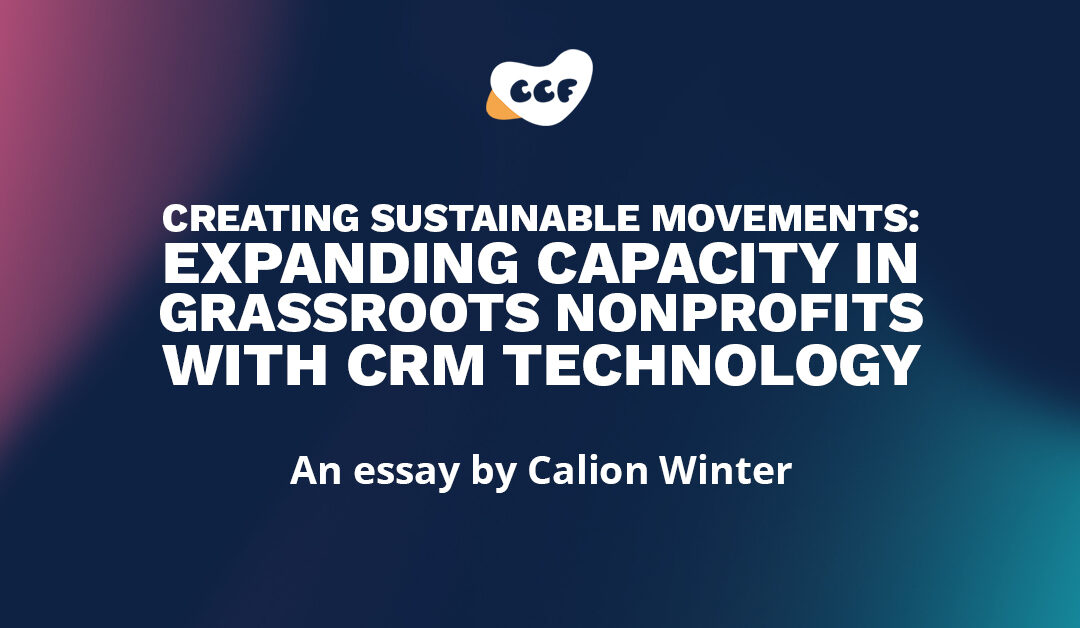By Calion Winter, a multiply-marginalized activist helping grassroots nonprofits expand capacity through technology
Many CRM programs are built to be highly customizable for entrepreneurs and small businesses both for revenue generation and streamlining workflows. So, what if we used these programs for nonprofits? And, most importantly, used them to their fullest extent?
We’re always asking philanthropists to change their funding methods to support our often-neglected grassroots initiatives, but what would happen if our organizations took power back into our own hands? Instead of relying on new limited funding opportunities, what if we were able to create sustainable operational systems within existing budgets?
This was the question I posed to a room of trafficking survivors, philanthropists, and human rights organizations while the fresh air of springtime in Kenya wafted in.
Before that, the discussion focused on how funders could shift their grantmaking strategies to better support grassroots organizations, especially those in the Global South or organizations led by systemically marginalized groups.
But, let’s be honest—will funders really change their rhythm? They may, but we can’t count on that.
So, how do our organizations bring the power of capacity expansion back into our own hands when facing the struggle to find multi-year staff grants?
Using CRMs to Streamline Operations and Increase Capacity
CRM, or Customer Relationship Management software, is a powerful and affordable (or sometimes free!) technological tool. Most organizations are already familiar with donor-specific CRMs or highly complex programs like Salesforce. The former offer costly ways to manage donors, with little flexibility and customization. The latter is often too complicated for organizations to maintain or use fully.
There’s a happy medium.
Many CRM programs are built to be highly customizable for entrepreneurs and small businesses both for revenue generation and streamlining workflows. So, what if we used these programs for nonprofits? And, most importantly, used them to their fullest extent?
I originally discovered the robust capacity-expanding power of CRMs because of my own journey as a multiply-disabled entrepreneur. With only 15 hours of direct effort possible each week, I had to find ways to do more without actually doing more. CRM technology allows me to handle most of my communications and project workflows, almost like a virtual assistant (literally on the virtual part!).
So, a few years later, it clicked in a conversation with a grassroots nonprofit that asked for assistance in securing the staff grant they needed to fund their $50k/year Operations Manager position. I looked over the description and realized something huge: “You can automate all of this.”
Using CRM automation to expand human capacity, not replace it
Even one small workflow built into their CRM saved them over 10 hours of work per member—meaning they could onboard and reach around 10x more survivors yearly.
The entire job was focused on tedious, recurring tasks. Sending documents to new members, managing data spreadsheets, emailing donors to reconnect, giving members a virtual tour of their platform, hosting recurring pre-recorded trainings, and sorting through volunteer applications to connect them to the right team member or online training or evaluation.
Every single one of these tasks could be done through technology, plus so much more.
I’m a firm believer in using technology to expand our capabilities as organizations, not to replace it. I’m not for generative AI and its exploitative history; I’m for solutions that help organizations grow while delivering a better experience to every person reached and preventing staff burnout along the way.
So, instead of spending 10-15 hours a week on these recurring digital tasks, their team could focus on actual communication with members and donors—letting the tech handle the tedious.
Plus, instead of looking at a $50k/year Operations Manager position, they could fund the entire role with a $500/year CRM subscription. They’d also need one-time help to create the tech system—but that cost only a small portion of what they were looking at for a staff grant. It was much easier to land a $20k technology or communications grant.
Best part? Even one small workflow built into their CRM saved them over 10 hours of work per member—meaning they could onboard and reach around 10x more survivors yearly.
Using technology offered real, tangible capacity growth.
How to apply CRM strategy to expand capacity in grassroots organizations
The most important thing for us to start doing is expanding our vision of what CRMs can do for nonprofits. They aren’t just for donors or events! Instead, a general CRM (think Hubspot or ActiveCampaign) can be customized to nearly every workflow within an organization, outside of in-person or person-led trainings or meetings.
Everything from document signing, new member onboarding guides via emails or SMS, online trainings, event management and follow-up, KPI tracking, donor follow-up and re-engagement, volunteer onboarding, and management…that’s all possible.
As a disabled trafficking survivor, I’m also passionate about healing-centered engagement (aka “being trauma informed”) and accessibility.
Hosting member onboarding, donor outreach and retention, and volunteer management through a CRM leads to a more predictable and responsive experience for all new beneficiaries, preventing that stressful experience of not knowing what to expect or waiting in limbo for a year before staff could onboard them! After all, a CRM can be programmed to respond promptly and consistently and can fuel automatic communication between a new member and the nonprofit team.
CRMs also allow for great customization, like screen-reader-adapted emails, multilingual segmentation, and different communication preferences through a user’s click of a button. Consent is streamlined and prioritized. Data is better protected. Instead of manual team effort to make everything accessible upon request (not ideal for either party!), everything can be automatically built for accessibility.
CRMs help organizations create more intuitive and responsive communication centers, allowing for a greater programmatic reach within limited staff hours while preventing staff burnout.
Applications to grassroots organizations, marginalized community movements, and the Global South
Recurring staff funding is a great source of scarcity for small organizations. Far too many organizations doing the most important work fall apart because funders deny them an expected grant. I believe our movements and organizations can reclaim this power when we seek grants to build long-lasting tech systems to support our most critical and foundational operations.
Instead of needing multi-year staff grants, both global donor-based revenue and capacity can grow with a single tech or operational grant.
For philanthropists and funders, here’s my request: Partner with professionals familiar with the full extent of CRMs and fund systems through them for organizations. This costs a fraction of a multi-year staff grant, allowing funds to be distributed to more organizations doing critical movement-building and justice-focused work, especially in underfunded areas and fields.
Staff will still be essential, but in lieu of funding, CRM systems offer a way to keep organizations thriving even when political situations, country-based funding limits, and global conflicts interrupt our intent to fund the most important human-driven missions on the planet.
Most importantly, it provides a solution for expanding capacity in organizations often denied recurring funding due to the movements and identities they exist within. It brings the power back to organizations with customized systems best for what they need, not what funders impose upon them.

Calion Winter
As a multiply-marginalized trafficking survivor, Calion Winter (he/they) has been a passionate international activist for over ten years. His experience with severe disability has created a deep desire to innovate ways to expand movements in the midst of great limitations. He founded Taking Routes to do this and, through it, helps nonprofits expand capacity and revenue through CRMs and other technological solutions.
Discover more from CCF
Subscribe to get the latest posts sent to your email.

